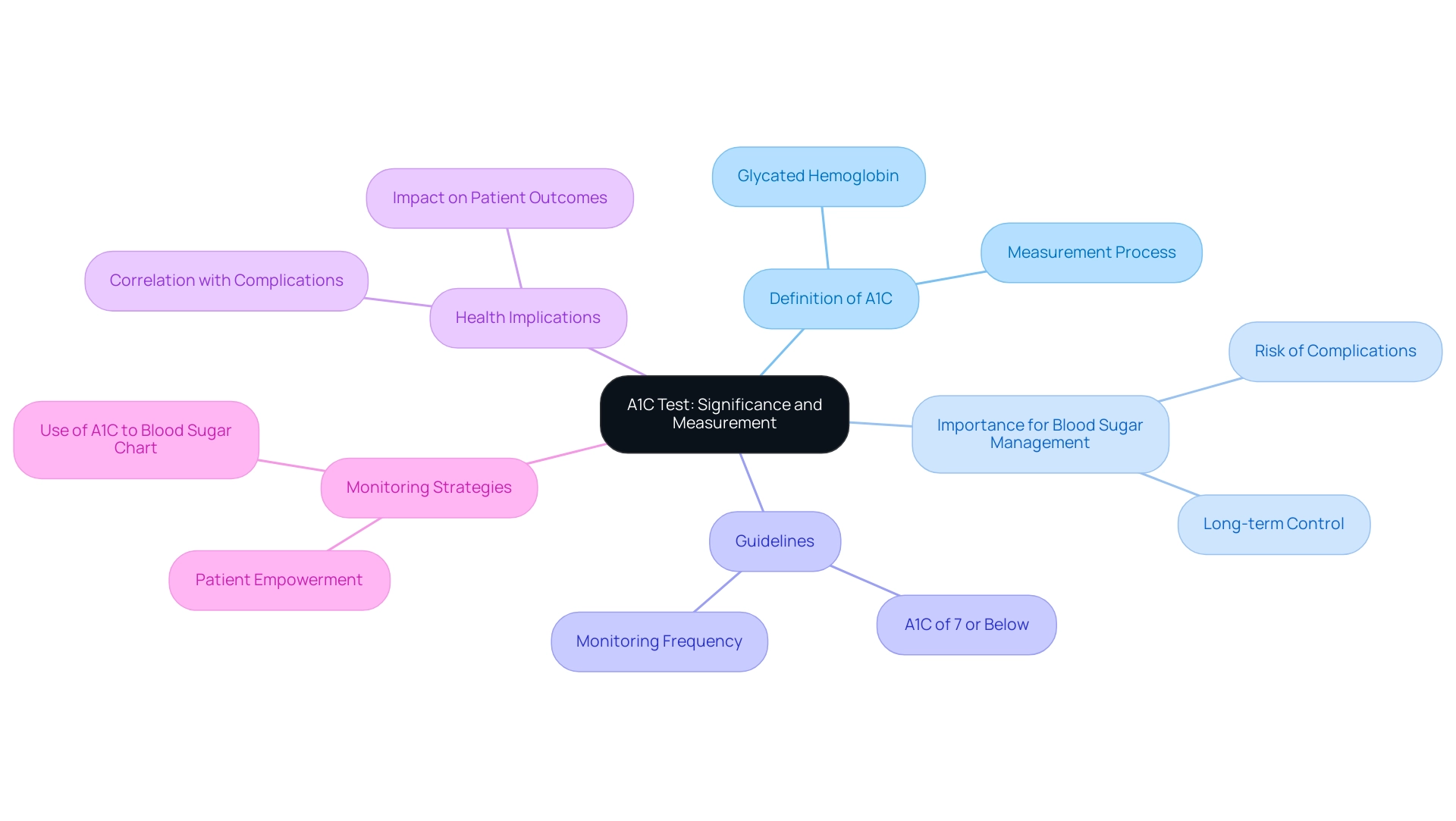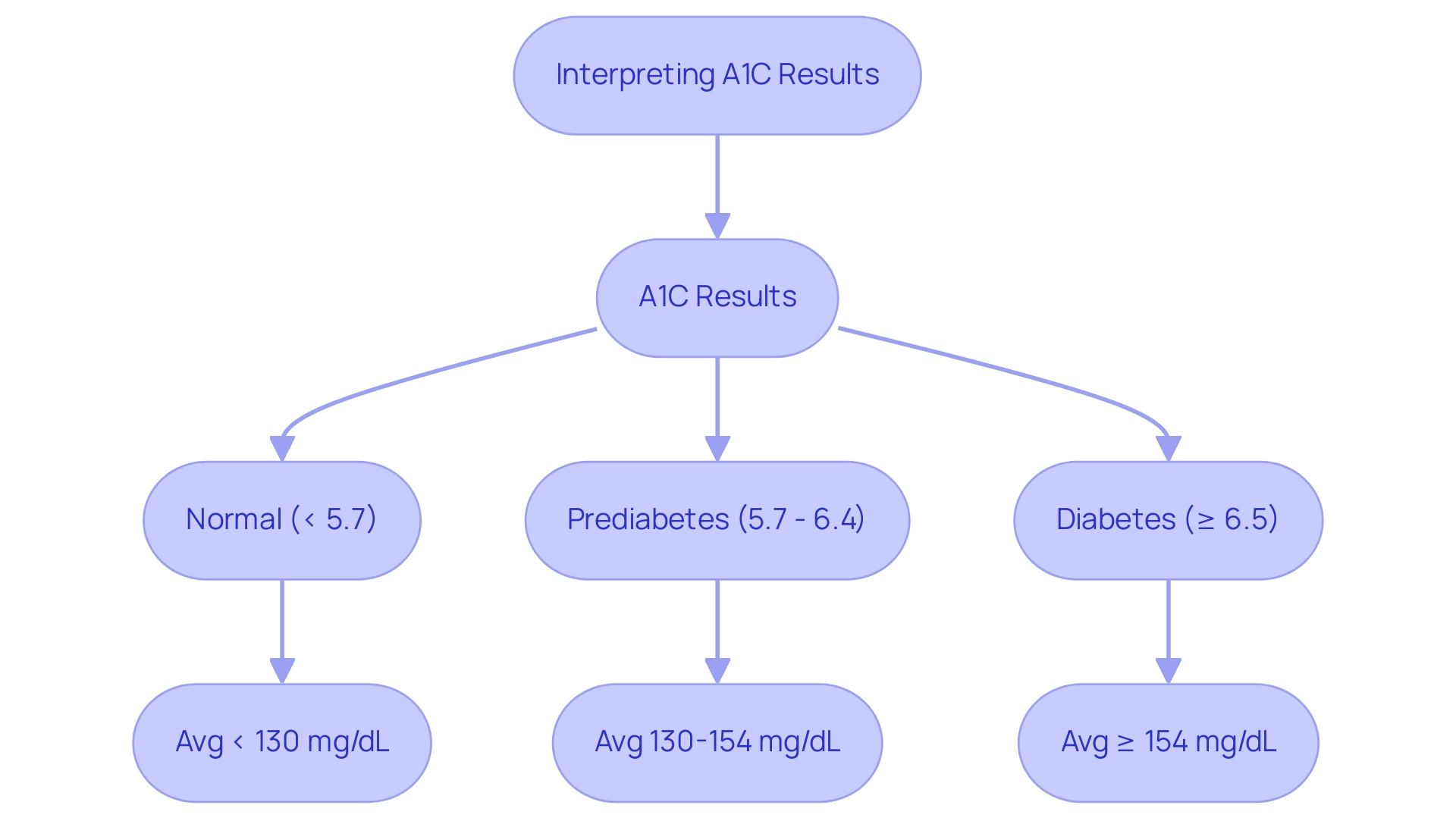Introduction
Understanding diabetes management is essential for individuals navigating their diagnosis, particularly when it comes to the A1C test—a key indicator of long-term blood sugar control. This test measures the percentage of hemoglobin in the blood that is bound to glucose, providing valuable insights into a patient’s average blood sugar levels over the past two to three months.
With diabetes affecting a significant portion of the population, the importance of regular A1C monitoring cannot be overstated. Elevated A1C levels signal a need for intervention, as they correlate with increased risks of complications.
This article delves into the significance of the A1C test, how to interpret its results, the establishment of personalized goals, and the necessity of consistent monitoring, all aimed at empowering individuals with the knowledge to manage their diabetes effectively.
Understanding the A1C Test: Significance and Measurement
T2DSolutions is excited to introduce itself as a brand new comprehensive resource hub dedicated to Type 2 and Type 3 blood sugar management education and community support. As we are just getting started, grasping the control of blood sugar levels is crucial for newly diagnosed patients, and one essential aspect is understanding the A1C to blood sugar chart, commonly referred to as the glycated hemoglobin test. This assessment measures the percentage of hemoglobin in the blood that is attached to glucose and is essential for managing blood sugar, as it provides a thorough summary of average blood sugar readings over the past two to three months, which can be tracked using an A1C to blood sugar chart.
This allows healthcare providers and patients alike to evaluate long-term glycemic control. With a prevalence rate of 14.3%, the impact of this condition is significant. An elevated A1C percentage, as shown on the A1C to blood sugar chart, indicates suboptimal blood sugar control and correlates with an increased risk of complications related to the condition, making it essential for patients to monitor their measurements closely.
The general guideline indicates that an A1C measurement of 7% or below is usually suitable for most adults diagnosed with this condition, as referenced in the A1C to blood sugar chart. T2DSolutions aims to empower patients by providing essential insights like these, emphasizing the necessity of consistent monitoring and its influence on effective treatment strategies. According to Roopa Naik, 'The A1C test is essential for understanding long-term glucose control, which can be effectively monitored through an A1C to blood sugar chart, aiding in informed treatment decisions.'
Recent studies underscore the test's significance, revealing that a well-maintained A1C level, as indicated in the A1C to blood sugar chart, can significantly improve patient outcomes. Furthermore, initiatives such as the 'Advocacy for Young Children' case study illustrate ongoing efforts to enhance care and support for individuals with the condition, reinforcing the relevance of A1C testing in various settings. As T2D Solutions evolves, we encourage you to subscribe and remain informed about our resources created to assist your journey in health control.

Interpreting A1C Results: What Do the Numbers Mean?
Welcome to T D Solutions, your complete resource for Type 2 and Type 3 blood sugar control and education. As we prepare to launch this brand new site, we invite you to subscribe for updates so you can stay informed about our latest content and resources. Our goal is to provide you with valuable insights and support for managing your condition effectively.
Understanding the A1C to blood sugar chart is a vital component of managing blood sugar levels. A1C results are expressed as a percentage and can be interpreted using an A1C to blood sugar chart, reflecting the average blood sugar concentrations over the past two to three months. Here’s how to interpret the A1C percentages:
- Normal: An A1C value below 5.7% indicates that blood sugar concentrations are within the normal range.
- Prediabetes: An A1C value ranging from 5.7% to 6.4% suggests a prediabetic condition, which significantly raises the risk of progressing to type 2 mellitus.
- Diabetes: A diagnosis of this condition is made with an A1C value of 6.5% or higher. Each increment in A1C corresponds to a rise in average blood sugar levels, which can be illustrated on an A1C to blood sugar chart; for instance, an A1C of 7% is associated with an average blood glucose level of approximately 154 mg/dL.
Recent findings highlight that 11.1% of adults met all recommended criteria for A1C, blood pressure, cholesterol, and smoking cessation, while a more lenient goal was achieved by 36.8% of adults. This highlights the difficulties in managing the condition. Furthermore, according to Parker ED in 'Economic Costs of Diabetes in the U.S. in 2022,' the total economic impact of the condition was estimated at $413 billion, with direct costs rising from $227 billion in 2012 to $307 billion in 2022. This emphasizes the significance of monitoring A1C levels using an A1C to blood sugar chart.
Interacting with healthcare professionals to talk about A1C results and suitable treatment plans is crucial for effective health oversight. Stay tuned for more updates from T2DSolutions as we strive to become your primary hub for education and community support. We will provide a variety of resources, including expert articles, community forums, and personalized support, to help you on your health journey.

Setting Goals Based on A1C Results
Establishing realistic and achievable A1C targets is crucial for effective management of the condition, particularly for newly diagnosed patients who can use the a1c to blood sugar chart for reliable information and support. Generally, an A1C goal of 7% or lower is recommended for most adults with this condition. However, these targets should be personalized, considering factors such as age, duration of the condition, and any coexisting health issues.
For older individuals or those with a history of lower A1C levels, less stringent goals may be advisable to mitigate the risks associated with overly tight glucose control. According to the American Diabetes Association Professional Practice Committee, 'For people with type 2 conditions, the discontinuation of all medications may be a reasonable approach, as these individuals are unlikely to have any oral intake.' This emphasizes the need for customized approaches in managing blood sugar conditions.
T2DSolutions strives to be your all-inclusive resource for Type 2 and Type 3 blood sugar control, providing a range of services, such as:
- Educational articles
- Support groups
- Tailored care plans
A cooperative strategy with healthcare teams is crucial to create a comprehensive care plan that considers individual situations and encourages optimal health results. Notably, this article has garnered 357,069 views, underscoring its relevance to a wide audience.
Additionally, a case study titled 'Real World Evidence Analysis of Medicare Population' examined a Medicare population of 4,243 individuals, predominantly with type 1 metabolic disorder, and found that initiating hybrid closed-loop insulin delivery was associated with improvements in mean glucose levels and a 10% increase in time in range. This case study demonstrates the practical use of personalized A1C goals in care and emphasizes the significance of utilizing resources like the a1c to blood sugar chart for effective strategies.

Regular Monitoring of A1C Levels
As individuals identified with the condition steer through their care journey, they are recommended to have A1C testing at least twice a year if they are meeting their treatment objectives. For those whose treatment regimens have been altered or who are struggling to meet their targets, more frequent testing—approximately every three months—may be warranted. According to recent statistics from the American Diabetes Association, regular A1C monitoring is associated with a 30% reduction in diabetes-related complications.
Monitoring A1C levels using the A1C to blood sugar chart is vital for evaluating the effectiveness of the current health control strategy and establishing if changes are needed. Regular consultations with healthcare providers regarding the A1C to blood sugar chart can facilitate timely interventions, thereby enhancing overall health outcomes. T2DSolutions is committed to assisting newly diagnosed patients with resources and information on A1C testing and condition control strategies, which include personalized monitoring plans and educational materials about the A1C to blood sugar chart.
As noted by the American Diabetes Association Professional Practice Committee, 'There remains strong consensus that establishing a uniform approach to diagnosing GDM will benefit people with GDM, caregivers, and policymakers.' This perspective highlights the broader implications of effective monitoring practices in managing blood sugar. Furthermore, the case study titled 'Management of Diabetes in Pregnancy' emphasizes the importance of inclusive language and interprofessional care, which can contribute to better glycemic control and health outcomes.
Additionally, recent findings regarding mutations in HNF1B highlight the need for personalized monitoring strategies, linking genetic factors to effective diabetes management.

Conclusion
Understanding diabetes management is paramount for individuals looking to take control of their health, and the A1C test plays a pivotal role in this process. This test not only provides a snapshot of average blood sugar levels over the past two to three months but also serves as an essential tool for determining long-term glycemic control. Recognizing the significance of A1C results—normal, prediabetes, and diabetes—is crucial for making informed decisions regarding treatment and lifestyle adjustments.
Setting personalized A1C goals is equally important, as it allows individuals to tailor their management strategies according to their unique circumstances. While a general target of 7% or lower is recommended for most adults, factors such as age and coexisting health conditions must be considered to ensure safe and effective diabetes management. Regular monitoring of A1C levels reinforces the commitment to achieving these goals and minimizes the risk of complications.
In summary, the A1C test is more than just a number; it is a vital indicator of diabetes management that can lead to better health outcomes. By understanding and utilizing this test effectively, individuals can work closely with healthcare providers to create a comprehensive diabetes management plan that promotes optimal health and well-being. As awareness and education around A1C testing continue to grow, so too does the potential for improved quality of life for those living with diabetes.



